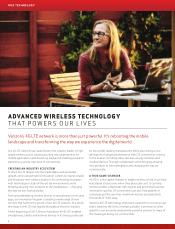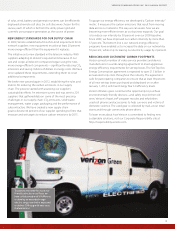Verizon Wireless 2012 Annual Report Download - page 18
Download and view the complete annual report
Please find page 18 of the 2012 Verizon Wireless annual report below. You can navigate through the pages in the report by either clicking on the pages listed below, or by using the keyword search tool below to find specific information within the annual report.
We’re using our advanced mobile and broadband technology to prepare students for
success in the 21st century.
Student achievement in a science, technology, engineering and
math (STEM) curriculum is critical to U.S. economic growth and
competitiveness on the global stage. Studies have shown that the
use of technology in the classroom can improve the way teachers
teach and keep students engaged and excited about learning.
We believe broadband and mobile technologies are the keys
to answering the challenge of driving greater achievement in
American schools as educators reinvent the classroom around
interactive and collaborative methods of instruction.
To personalize the classroom experience, we’re developing
innovative products that adapt our technologies to the needs of
students. We’re building partnerships with education organizations
that embrace the idea of mobility and digital content. We’re
also launching pilot programs with major universities to prepare
college students for teaching careers by integrating technology,
mobile devices, learning systems and cloud computing into their
college curriculum.
INNOVATIVE LEARNING SCHOOLS
Last year we launched the Verizon Innovative Learning School
program in 12 schools in underserved areas across America.
Teachers received extensive training on innovative ways to use
technology in the classroom, provided by the International Society
for Technology Education via a grant from the Verizon Foundation.
Samsung donated Galaxy tablets for the program, which started
with a summer workshop and continued with ongoing training
throughout the academic school year.
Schools receive grants ranging from $33,000 to $50,000. Verizon
targeted schools in which at least 40 percent of the students are
eligible for free and reduced lunches.
To determine our impact, we will measure teacher and student
technology prociency and student achievement. Early results
indicate that teachers are able to individualize instruction
and implement new strategies to better engage students in science
and math. The program will reach as many as 12,000 students
in 24 U.S. schools in 2013.
Students at Our Lady of Mt.
Carmel School in Essex, Maryland,
use Verizon 4G LTE-enabled
tablets as part of their instruction.
Studies show that technology in
the classroom helps keep students
engaged and excited about learning.
HOW CAN WE GIVE STUDENTS
A BETTER EDUCATION?
POWERFUL ANSWERS
16
























